photo © T. Boughen Camera: Nikon Z 5
Thursday, 30 May 2024
Minehead harbour and pier
Today's photograph is a view of Minehead harbour from the pier. It shows its location below a wooded hill with the oldest houses squeezed into a strip below the trees and more recent Victorian and later buildings at the head of the pier. Among the latter is the lifeboat station of 1901 which is still in use, housing two inshore rescue craft.
Tuesday, 28 May 2024
Minehead harbour
The first pier at Minehead in Somerset was built in 1610 when the harbour became an important export and import location. Today the the harbour is still in use but commercial traffic has gone to bigger ports elsewhere and pleasure craft far outnumber the few engaged in fishing. Unusually, this harbour is, and always was, at the edge of the built up area of the coast, and today it is a popular destination for a walk from the centre of the town.
photo © T. Boughen Camera: Nikon Z 5
Sunday, 26 May 2024
Medieval tiles, Cleeve Abbey
It isn't unusual to come across medieval tiles in cathedrals and monastic buildings, and it's very common to find Victorian tiles influenced by their designs. However, the number of such tiles is often quite low, which isn't the case at Cleeve Abbey in Somerset. Here there are thousands with a variety of heraldic designs all dating from the 1200s. They show similarities to tiles in Salisbury Cathedral Chapter House and Clarendon Palace. Cleeve's tiles are well-protected and displayed by English Heritage.
photo © T. Boughen Camera: Nikon Z 5
Labels:
Cleeve Abbey,
floor tiles,
heraldic,
medieval,
tiles
Friday, 24 May 2024
Steps, Cleeve Abbey
Cleeve Abbey, near Minehead in Somerset, was founded in 1198 by the Cistercians. The religious buildings no longer exist, but some domestic buildings still stand including the dormitory, refectory and cloister. My photograph shows some steps lit by a window. The weathered stone and plaster hint at the lost magnificence.
photo © T. Boughen Camera: Nikon Z 5
Labels:
Cistercian,
Cleeve Abbey,
Minehead,
Somerset,
steps
Wednesday, 22 May 2024
Horse chestnut flowers
The horse chestnut is not a native of the UK. It was introduced from Turkey in the late C16. Even today it is found more in parks and gardens than in woodlands or hedgerows. Its flowers appear in May and have been likened to candles - a tree in full flower is still sometimes called a candle tree even by someone who knows its more commonly used name. Each spear of flowers is bigger than a man's hand and they are usually well distributed across the tree, making a fine, if short-lived sight. The colours of the blooms, with pink, yellow and white often dominating, reminds me of the colourful, heaped up, cream, chocolate and fruit drinks offered by some coffee shops.
photo © T. Boughen Camera: Lumix FZ1000 2
Labels:
blooms,
flowers,
horse chestnut
Monday, 20 May 2024
River Wye swimmer
We are used to the variety of activities that take place on the River Wye at Ross on Wye, but recently we came upon a new one. It didn't involve scullers from the rowing club or hire canoes or paddle boards. Nor was it children paddling in the shallows of the shingle banks. What we saw was a swimmer determinedly breast-stroke swimming with the flow of the river. He was towing a waterproof container that, presumably, held his belongings, and acted as a buoyancy aid. It was this that made us think he must be a long distance swimmer undertaking a several mile swim. Not everyone spotted him, but the goosanders kept a close eye on him.
photo © T. Boughen Camera: Olympus OMD E-M10
Labels:
goosander,
River Wye,
Ross on Wye,
swimmer
Saturday, 18 May 2024
Translucent glass...
...or frosted glass, or etched glass, or opaque glass, or privacy glass, or sand blasted glass. I've heard all those names applied to the glass in windows that is designed to let in light but prevent someone outside seeing in. Translucent glass seems to me to be the best name because it best describes the ability to admit light but but prevent anyone looking through it seeing details. The example above is in a toilet/wash-room. Outside, when I took my photograph there was evening light falling on a street with, from the top, blue sky, bricks sunlit and in shade, a blue vehicle, yellow heather, green grass and grey tarmac.
photo © T. Boughen Camera: Nikon Z 5
Thursday, 16 May 2024
Peter de Grandison revisited
About five years ago I took a photograph of the tomb of Peter de Grandison (d.1358) in Hereford Cathedral. It is a typical of its date having a sculpture of the deceased on a raised, panelled tomb chest with rib vaulting and canopies above. The smaller figure carvings depict the Coronation of the Virgin and four saints (Cantilupe, Ethelbert, John the Baptist and Thomas Beckett). My focus this time was the depiction of Peter de Grandison and his armoured upper body. This probably received repairs after damage by iconoclasts. However, it outshines many tombs of its date due to the fine detail that was recoloured in a restoration of the 1940s. Incidentally, the surname can be spelled with a single or double s.
photos © T. Boughen Camera: iPhone
Tuesday, 14 May 2024
Church organ pipes
The church organ pipes that attract the attention of visitors are usually those that have received paintwork decoration - like this recently posted example, and this painted en chamade set at Usk church. But, there are many unadorned organ pipes in Britain's churches and they catch the eye with their simplicity, repetition and contrast, as with the example above in St Mary's church, Ross on Wye.
photo © T. Boughen Camera: Olympus OMD E-M10
Labels:
organ pipes,
Ross on Wye,
St Mary
Sunday, 12 May 2024
Leaping salmon sculpture
The sculpture shown in the photograph is a depiction of leaping salmon by the artist, Walenty Pytel. It was made in 1997, is constructed of steel with a granite base, and can be seen by the corner of the road next to "The Man of Ross" public house in Ross on Wye. It is one of three public sculptures by the artist in the town: the other two are by the River Wye and depict mallards and mute swans.
photo © T. Boughen Camera: Sony DSC-RX100
Labels:
Man of Ross,
Ross on Wye,
salmon,
sculpture,
steel,
Walenty Pytel
Friday, 10 May 2024
Greater Periwinkle
The gardens of the houses we have lived in have often featured the Greater Periwinkle (Vinca major). It is an attractive flower that appears early in the year and hangs on at the end of the season. Another of its strengths is its ability to grow, flower and make an impact in the shade of shrubs and trees. But, it has one drawback - it spreads relatively easily and finds its way to places where its undoubted charms are not welcome.
photo © T. Boughen Camera: Olympus OMD E-M10
Labels:
blue,
flower,
greater periwinkle,
Vinca major
Wednesday, 8 May 2024
A Tewkesbury house
Tewkesbury is a town with many fine, old buildings. It is particularly rich in domestic houses, most of which are unique in design: few houses on the main historic streets have neighbours that look the same as they do. The town has many timber-framed dwellings and the example above on Barton Street is a good indication of what can be seen.
It consists of three jettied storeys above the ground floor. These feature a C17 remodelling of a C16 structure. The only jarring note is the Victorian shop front window on the ground floor. Pride of place on the elevation is the first floor oriel window with its leaded lights. The bottom of the window is supported by C17 carved brackets (see photo 2).
photos © T. Boughen Camera: Olympus OMD E-M10
Monday, 6 May 2024
Newly appearing water plants
One of the houses we lived in had a pond with water lilies. I very much enjoyed photographing the lilies as they appeard in spring. But, more than that, I particularly enjoyed photographing them as they changed colour and faded away in autumn. I was reminded of that pond when we passed the weir on the Mill Avon at Tewkesbury. Water lily leaves were appearing. So too was another plant that produces, if my memory serves me well, broad spear-shaped leaves. They weren't yet filling this part of the river as they eventually will, so I took a photograph of the contrasting plants and their reflections.
photo © T. Boughen Camera: Olympus OMD E-M10
Saturday, 4 May 2024
C18 cartouche gravestone
To my mind the design of gravestones hit a peak in the C18. In the C17, as gravestones grew in popularity, they exhibited a naivety of subject and execution. In the C19 mass production, Gothic influences and grandiosity overwhelmed the original and innovative designs that can still be seen. C20 gravestones are usually more modest, machine-made and make use of too wide a variety of stone. The C18 used a limited palette of (usually local) stone, ornament and lettering. The example above, at St Michael, Walford, Herefordshire, has the typical winged putto head and foliage arranged as a cartouche. Rising damp has obscured the lower lettering, but above it is crisp and shows interesting abbreviations. If you look carefully you can still discern parts of the faint, scratched, guide-lines to keep the lettering level and of the correct height.
photo © T. Boughen Camera: iPhone
Labels:
C18,
cartouche,
Georgian,
gravestone,
Herefordshire,
lettering,
Walford
Thursday, 2 May 2024
Coleford mural
The small Gloucestershire town of Coleford is located in the Forest of Dean, a former coal mining and iron working area. On a wall of one of the town's houses is a mural that celebrates three writers who lived in the area - Joyce Latham, F.W. Harvey and Dennis Potter. I imagine that I am quite typical in that I don't know anything of the first two names. I do, however, know quite a bit about Dennis Potter, particularly his innovative series for TV that include Pennies from Heaven and The Singing Detective.
photos © T. Boughen Camera: iPhone
Subscribe to:
Comments (Atom)















